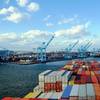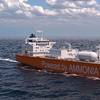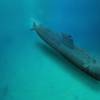SOLAS amendments and ISPS Code enter into force on 1 July 2004
Far-reaching international maritime security measures developed and adopted by IMO enter into force on 1 July 2004. The security measures, which include the International Ship and Port Facility Security Code (ISPS Code), are in the form of amendments to the 1974 Safety of Life at Sea (SOLAS) Convention and are aimed at enhancing maritime security on board ships and at ship/port interface areas. They were adopted by a Conference on Maritime Security in December 2002.
Other amendments to SOLAS entering into force on the same date include requirements for the fitting of water ingress alarms in holds, ballast and dry spaces on bulk carriers and requirements for radar transponders to be fitted in liferafts carried on ro-ro passenger ships.
Measures to enhance maritime security
The bulk of the new security measures are included in a new Chapter XI-2, entitled Special measures to enhance maritime security. The new chapter applies to passenger ships and cargo ships of 500 gross tonnage and above, including high speed craft, mobile offshore drilling units and port facilities serving such ships engaged on international voyages, and it enshrines the much-heralded ISPS Code.
The ISPS Code contains detailed security-related requirements for implementation by Governments, port authorities and shipping companies in a mandatory section (Part A), together with a series of guidelines about how to meet these requirements in a second, non-mandatory section (Part B). It is the first ever internationally agreed regulatory framework addressing the crucial issue of maritime security and represents the international maritime community's contribution to the global resistance against terrorism.
The Code requires a ship security plan to be drawn up for all SOLAS vessels, and for the plan to be approved by the flag State administration. Each ship must also have a designated ship security officer and each shipping company must appoint a company security officer. Similarly, port facilities are also required to have an approved security plan and to appoint a designated security officer.
Both shipboard and port facility security plans must set out the details of measures to be put in place at each of three escalating security levels. National Administrations are required to set the security levels and ensure that security level information is provided to ships entitled to fly their flag. Prior to entering a port, or whilst in a port, within the territory of a Contracting Government to the SOLAS Convention, a ship shall comply with the requirements for the security level set by that Contracting Government, if that security level is higher than the security level set by the Administration for that ship.
The new chapter confirms the role of the master in exercising his professional judgement over decisions necessary to maintain the security of the ship. The master shall not be constrained by the Company, the charterer or any other person in this respect.
It also requires all ships to be provided with a ship security alert system, fitted according to a strict timetable which requires most vessels to be fitted by 2004 and the remainder by 2006. When activated, the ship security alert system shall initiate and transmit a ship-to-shore security alert to a competent authority designated by the Administration, identifying the ship, its location and indicating that the security of the ship is under threat or has been compromised. The system will not raise any alarm on board the ship. The ship security alert system shall be capable of being activated from the navigation bridge and in at least one other location.
Other regulations in this chapter cover the provision of information to IMO, the specific responsibilities of shipping companies, and the control of ships in port, including measures relating to the delay, detention or restriction of operations including movement within the port or expulsion of a ship from port.
To improve the traceability of ships on the high seas, regulation XI-1/3 of the existing SOLAS Chapter XI on Special measures to enhance maritime safety (re-numbered as Chapter XI-1) is modified to require ships' identification numbers to be permanently marked in a visible place either on the hull or superstructure. Passenger ships should carry the marking on a horizontal surface visible from the air. Ships should also be marked with their identification numbers internally.
In the same vein, a new regulation XI-1/5 requires ships to be issued with a Continuous Synopsis Record (CSR) which is intended to provide an on-board record of the history of the ship. The CSR shall be issued by the Administration and shall contain information such as the name of the ship and the State whose flag the ship is entitled to fly, the date on which the ship was registered with that State, the ship's identification number, the port at which the ship is registered and the name of the registered owner(s) and their registered address. Any changes shall be recorded in the CSR so as to provide updated and current information together with the history of the changes.
Modifications to SOLAS Chapter V (Safety of Navigation) contain a new timetable for the fitting of Automatic Information Systems (AIS). Ships, other than passenger ships and tankers, of 300 gross tonnage and above but less than 50,000 gross tonnage, are required to fit AIS not later than the first safety equipment survey after 1 July 2004 or by 31 December 2004, whichever occurs earlier. Ships fitted with AIS shall maintain AIS in operation at all times except where international agreements, rules or standards provide for the protection of navigational information.
Other amendments to SOLAS adopted in December 2002
In addition to the security-related measures, a series of other important SOLAS amendments adopted in December 2002 by the expanded Maritime Safety Committee (MSC), also enter into force on 1 July 2004. They include:
Chapter XII (Additional Safety Measures for Bulk Carriers)
* New regulation XII/12 on Hold, ballast and dry space water level detectors requires the fitting of high level alarms and level monitoring systems on all bulk carriers, in order to detect water ingress. The regulation requires the fitting of such alarms on all bulk carriers regardless of their date of construction.
* New regulation XII/13 on Availability of pumping systems requires the means for draining and pumping dry space bilges and ballast tanks any part of which is located forward of the collision bulkhead to be capable of being brought into operation from a readily accessible enclosed space.
Chapter II-1 (Construction - structure, subdivision and stability, machinery and electrical installations)
* In Part B (Subdivision and stability), a new regulation II-1/3-6 Access to spaces in cargo areas of oil tankers and bulk carriers is intended to ensure that vessels can be properly inspected throughout their lifespan, by designing and building the ship to provide suitable means for access. Associated technical provisions for means of access for inspections are mandatory under the regulation. Without adequate access, the structural condition of the vessel can deteriorate undetected and major structural failure can arise. The regulation requires each space within the cargo area to be provided with an appropriate means of access to enable, throughout the life of a ship, overall and close-up inspections and thickness measurements of the ship's structures to be carried out.
* In Part C (Machinery Installation), a new paragraph added to regulation 31 (Machinery control) requires automation systems to be designed in a manner which ensures that threshold warning of impending or imminent slowdown or shutdown of the propulsion system is given to the officer in charge of the navigational watch in time to assess navigational circumstances in an emergency.
Chapter II-2 (Fire protection, fire detection and fire extinction)
* The amendments concern references to the IMDG Code and reflect amendments to SOLAS chapter VII (Carriage of Dangerous Goods) adopted in May 2002 which make the International Maritime Dangerous Goods Code (IMDG Code) mandatory.
Chapter III (Life-saving appliances and arrangements)
* Amendments to Regulation 26 (Additional requirements for ro-ro passenger ships) require liferafts carried on ro-ro passenger ships to be fitted with a radar transponder in the ratio of one transponder for every four liferafts. The regulation is made applicable to existing ships as well as new ships.
INF Code
* The amendments to the International Code for the Safe Carriage of Packaged Irradiated Nuclear Fuel, Plutonium and High-Level Radioactive Wastes on board Ships (INF Code) in the sections on definitions and application reflect amendments to SOLAS chapter VII (Carriage of Dangerous Goods) adopted in May 2002 which make the IMDG Code mandatory.
Featured videos

Taking the First Step Toward Autonomy

Send in the Drones (to deep, dark, confined maritime spaces)
October 2024
 Read the Magazine
Read the Magazine

 Read the Magazine
Read the Magazine
This issue sponsored by:

Congestion, Emissions, Highway Construction and Engineering Ethics
Subscribe for
Maritime Reporter E-News
Maritime Reporter E-News is the maritime industry's largest circulation and most authoritative ENews Service, delivered to your Email five times per week









